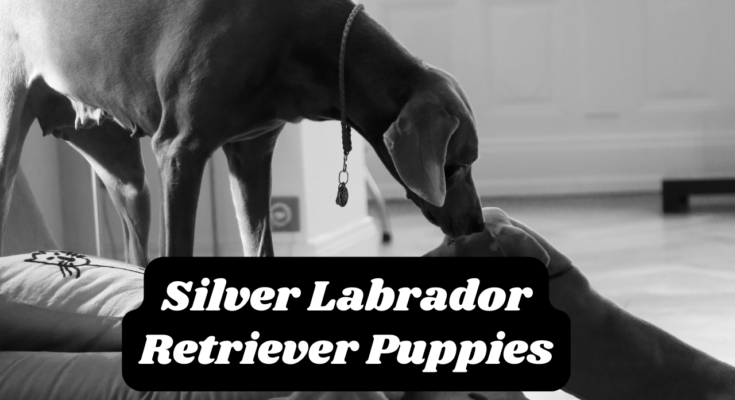Earliest Records of the Silver Labrador Retriever Puppies in History:
One of the furthermost quintessential American dogs, the Silver Labrador Retriever Puppies was actually first breed in Newfoundland from the St. John’s dog (now extinct) and the British retriever. The breed has existed since the early 1800s, but these dogs slowly ended their technique to the United States from Canada and the U.K. almost one hundred years later. The AKC formally documented the Labrador retriever as a breed in 1917, but they didn’t grow famous overnight. It wasn’t until the 90s that the lab gained its current status as the most popular dog in America.
They’ve been voted the most popular for 31 consecutive years and are now considered the most loved dog in the world. Of course, we’re mostly talking about the standard chocolate, black, and yellow labs, but silver Labradors have been included in the mix in some circles to some extent since they first appeared in the 1950s.
How the Silver Labrador Gained Popularity:
While Labrador retrievers were first in their home country in Newfoundland, they were frequently fishermen’s dogs since they loved water and had unbelievable fetching skills. The silver Labrador first became recognized in the 1950s and gained notoriety finished controversy over their origins.
Silver Labrador Retrievers, also known as “silver labs,” have been the center of attention for quite some time now. Their striking silver coats, sparkly blue eyes in their puppyhood, and fun-loving personalities have captured the hearts of many dog enthusiasts. Silver Labrador Retrievers have recently gained attention and popularity due to their striking silver-gray coat color. However, this unique color has sparked some controversy among both breeders and dog lovers.
Silver Labrador Facts:

Size: Medium to Large
Weight: Typically between 55 to 80 pounds
Coat Color: Silver-gray
Coat Type: Short and dense
Temperament: Friendly, outgoing, and playful
Lifespan: Usually 10 to 14 years
Exercise Needs: Active breed requiring regular exercise and playtime
Silver Labs are a distinctive type of Labrador Retriever with a gray coat, yellow eyes & muscular build. They have friendly personalities but can be prone to separation anxiety, so need plenty of attention. Regular exercise is important for keeping them healthy & happy, great family.
Top 3 Unique Facts about the Silver Labrador Retriever:
1. Silver Labradors aren’t the only unusually colored labs in controversy:
There’s also a fox-colored Labrador which isn’t accepted in the show ring.
2. They’re more at risk for color dilution alopecia:
Silver labs are considered comparatively healthy dogs; their genes make them extra susceptible to this health problem that can source thinning hair and flaking, dry skin.
3. They’re a little more expensive:
Silver Labrador is officially known as a chocolate lab, they’re a little pricier than their more common counterparts. Possibly this is due to the comparatively rare, beautiful color of their coat.
Genetics overdue the Silver Coat:
The Silver Lab’s distinctive coat color is a produce of their unique genetics. The dilute gene (d) is responsible for creating a diluted coat color when two copies are present in a dog’s genetic makeup.
How does gene work?
The dilute gene comes in pairs – the big ‘D’ and little‘d’. The big ‘D’ offers a much bolder and stronger coat color. On the contrary, the little‘d’ leads to a weaker shade of the same color. When a Chocolate Lab carries two copies of the dilute gene (dd), it results in a Silver Lab. This genetic combination is what creates the stunning silver coat that sets these dogs apart from their more traditional Labrador counterparts.
Though the debate about the origins of Silver Labs continues, the role of the dilute gene in creating their silver coat is undeniable. This genetic factor is what makes Silver Labs truly unique and captivating.
Appearance and Physical Traits:

Silver Labs, also known as silver Labrador retrievers, are a unique type of Labrador Retriever. What sets the silver Labrador retriever puppy apart from other labrador retrievers is their signature gray coat. In addition to their coat, Silver Labs have:
- Yellow eyes
- A brown nose
- Long floppy ears
- Wide skulls
- A muscular build
A Silver Lab puppy is particularly enchanting with its sparkly blue eyes and smoky grey shade. Over time, these blue eyes will change to yellow, typically between 6 and 8 months of age.
Male Silver Labs can weigh up to 80 pounds and stand around 24.5 inches tall. Females, on the other hand, usually weigh up to 70 pounds and stand at about 23.5 inches. This puts Silver Labs in the same size range as other Labrador Retrievers, making them a perfect fit for families looking for a medium to large-sized dog.
Temperament and Personality:
Renowned for their friendly, affectionate, and caring personalities, Silver Labs are:
- Intelligent
- Easy-going
- Social creatures that flourish with attention and enjoy engagements with children and other pets
- Easy to train outstanding to their high intelligence and eagerness to please
- Playful and energetic, preserving this nature as they grow older
Silver Labs can be prone to separation anxiety, so it’s significant to deliver them with ample friendship and consideration. While Silver Labs are great with kids, their high energy levels and potential for nipping throughout play can variety them less suitable for families with toddlers. For families with older children, conversely, Silver Labs make fantastic playmates and loyal companions.
Health Issues and Concerns:
Silver Labs may encounter specific health issues. Certain health apprehensions particular to Silver Labs encompass:
- Hereditary myopathy
- Hip and elbow dysplasia
- Exercise-induced collapse
- Ear infections
- Overeating
Hereditary myopathy is a genetic condition that can cause:
- Muscle weakness
- Stunted growth
- Difficulty swallowing
- A stiff arched back
- Reduced muscle mass
- Low tolerance for exercise
Hip and elbow dysplasia, on the other hand, is a painful condition make happen by improper development of the hip or elbow joints, needful special care. Exercise-induced collapse is another health issue that can upset Silver Labs, along with ear infections. Overeating can lead to obesity and other health problems if not properly managed.
Nutrition and Diet:
Silver Labrador receives the best food is fundamental to their health and well-being. Here are some key points to consider:
- A high-quality, protein-rich diet with adequate calcium for joint development is key to maintaining a healthy Silver Lab.
- Portion sizes should be based on dog’s size and weight.
- Divide their meals into 3-4 intervals to prevent overeating.
Adult Silver Labs typically require between 1650-2400 calories per day. It’s crucial to monitor Silver Lab’s caloric intake to ensure that they maintain a healthy weight and avoid obesity-related health issues. By providing Silver Lab with a nutritious and balanced diet, you’ll help them stay strong, energetic, and healthy.
Training and Exercise Requirements:
Regular exercise is a necessity for Silver Labs to maintain physical and mental health. It’s recommended that they receive at least 60 minutes of daily exercise, including activities like playing fetch, running, and going on walks. In addition to physical activity, Silver Labs also need mental stimulation to retain their minds sharp and engaged. Interactive toys and games can provide this mental stimulation, keeping Silver Lab happy and well-rounded. Starting training at a young age is essential for Silver Labs, as they are highly intelligent and eager to learn.
Activities such as dog sports, swimming, and interactive games are excellent ways to engage Silver Lab in both physical and mental exercise. It’s important to note that Silver Labs can be prone to separation anxiety. Ensuring that they receive adequate exercise and mental stimulation can help alleviate this issue and keep Silver Lab content and well-adjusted. By meeting Silver Lab’s exercise and training requirements, you’ll not only help prevent potential health issues, but also strengthen the bond between you and your furry companion.
Grooming and Maintenance:
Like all Labradors, Silver Labs possess a double coat that necessitates regular grooming to preserve their optimal appearance. Weekly brushing and bathing every six weeks are recommended for Silver Labs to maintain a healthy and clean coat. A good short hair brush can be used to groom Silver Lab, keeping shedding to a minimum. In addition to their coat, special attention should be given to a Silver Lab’s ears. Regular ear checks and cleaning can help prevent ear infections, which are a common health issue in this breed.
Proper grooming and maintenance are essential not only for Silver Lab’s appearance, but also for their overall health. By adhering to a regular grooming routine, you’ll help ensure Silver Lab stays clean, happy, and comfortable.
Finding a Reputable Breeder:
Owing to the contentious debate about Silver Labs’ origins, it’s vital to locate a reputable breeder when considering the addition of these remarkable dogs to your family. A reputable breeder will prioritize proper health testing and responsible breeding practices to ensure the well-being of their Silver Lab puppies.
When searching for a Silver Lab breeder, make sure the parents of the puppy have been tested for the following:
- Hip dysplasia
- Progressive retinal atrophy (PRA)
- Exercise-induced collapse (EIC)
- Centronuclear myopathy (CNM)
This will help to ensure that new Silver Lab puppy has the best possible start in life, free from potential health issues. It’s also essential to research and find a breeder who is knowledgeable about the breed and dedicated to producing healthy, well-adjusted Silver Labs. By choosing a reputable breeder, you’ll not only be supporting ethical breeding practices but also ensuring the long-term health and happiness of new Silver Lab puppy. Finding the right breeder may take time and effort, but the reward of bringing home a healthy, happy Silver Lab will be well worth it.
Silver Labs and Family Life:
Silver Labs prove to be excellent family pets, particularly for energetic households with older children. Their friendly, affectionate, and caring personalities make them a joy to have around the home. However, their high energy levels and potential for nipping during play may not make them a good match for families with toddlers. For families with older children, Silver Labs are an ideal companion.
Their playful and energetic nature will keep kids entertained, while their loyalty and loving temperament will provide a strong bond between the dog and its family. Ultimately, Silver Labs are a wonderful addition to family life for those who appreciate their unique coat color, fun-loving personalities, and dedication to their human companions. Their beauty and charm make them an unforgettable and cherished part of any family.




